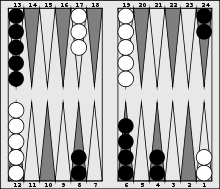Backgammon notation


Backgammon notation is a means for recording backgammon games, developed by Paul Magriel in the 1970s.[1] The common way of describing the movement of checkers involves numbering the points around the board from 24 to 1 as depicted in Figure 1.[2]
The image shows the board from black's perspective, with the numbers diminishing as her checkers move counterclockwise toward her own home board at the bottom right-hand side. The reverse numbering of the points applies when white is on roll, with the 24-point referred to as the 1-point, and so forth.
Dice rolls are shown either as "4-2" or "42", denoting a roll of four on one die and two on the other. Moves are recorded using the notation:
- 4-2: 8/4 6/4
This denotes a roll of 4-2, and the corresponding checker moves from point 8 to 4 and from 6 to 4.[1][2] After this move, the board will appear as shown in Figure 2.
If a move results in a checker being hit, this is indicated by adding an asterisk to the number denoting the point at which the checker was hit. For example, 13/7* denotes a checker moving from the 13-point and hitting an opposing checker at the 7-point. Similarly, 13/7*/5 denotes a move corresponding to a roll 6-2 and a checker moving from 13 to 5 hitting a checker at the in-between step at point 7.[1][2]
Moves resulting from double rolls are often indicated by placing the number of checkers moved in parentheses after the move. For example, the effect of a roll 2-2, could be: 6/4(3) 13/11.[1][2]
Finally, it is common to use the words "bar" and "off" to describe moves where checkers are entered from the bar or taken off during bear off. For instance bar/22 17/9, and 5/off 2/off.[1][2]
References
- 1 2 3 4 5 Robertie, Bill (2002). Backgammon for Winners. Cardoza Publishing. p. 101. ISBN 1-58042-043-5.
- 1 2 3 4 5 Magriel, Paul (1976). Backgammon. Quadrangle/The New York Times Book Co. pp. 16–18. ISBN 0-8129-0615-2.
